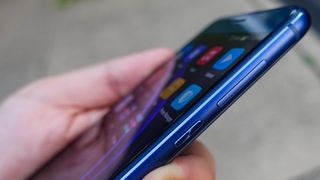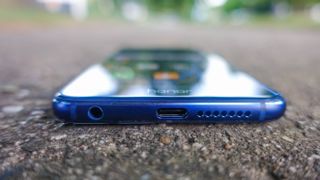OUR VERDICT
The Honor 8 is the fanciest-looking Android phone yet out of China, with an awesome, light-refracting glass design and high-end specs, but other less shiny budget phones offer better value.
The Honor 8 is the fanciest-looking Android phone yet out of China, with an awesome, light-refracting glass design and high-end specs, but other less shiny budget phones offer better value.
The Essential Review
This is TechRadar’s review summary that gives you all the key information you need if you’re looking for quick buying advice in 30 seconds – our usual full, in-depth review follows.
The Honor 8 costs the same as its closest rivals, the ZTE Axon 7 and OnePlus 3, and similarly only works on GSM carriers like AT&T and T-Mobile in the US. It's the prettier of the three, but the only one to start at 32GB instead of 64GB.
It’s therefore automatically the third wheel due to its later launch date, smaller entry-level size and illogical software choices – like no app drawer.
That’s okay, it does other things right. The Honor 8 thinks outside the box with inventive gesture shortcuts and a dual-rear camera for sharper than average photos on a mid-range phone. There’s also an IR blaster so your phone can become your TV remote, and a rear fingerprint sensor that can be customized with all sorts of single and double-tap shortcuts.
Honor 8 relies on these novel features to differentiate itself beyond its light-diffracting good looks and tempting price, to make a strong case for becoming your next shiny object.
Who's this for and should I buy it?
The Honor 8 is the perfect smartphone for anyone who wants a trendy-looking device, but doesn't want to break the bank. It's affordable and takes good selfies from the front-facing camera, making millennials the ideal buyers. Just don't expect it to be too water-resistant or play VR games. It's not that trendy.
It's hard to find a better phone at this price range that's also suitable for one-handed operation. The ZTE Axon 7 is a close rival, but its 5.5-inch screen isn't going to appeal to the same crowd.
Price and release date
- Unlocked price is $399 in the US, and £369 in the UK
- Only compatible with AT&T and T-Mobile in the US
- But you won’t find it in normal carrier stores in the US
You won’t find the Honor 8 in carrier stores in the US and you can’t buy it on a device payment plan. It’s available at full price through Best Buy, Amazon and Huawei, having launched in August 2016.
It costs $399 in the US and £369 in the UK SIM-free with 32GB of storage. A 64GB configuration costs $449 and is only sold in the US. The Honor 8 supports microSD cards and adoptable storage, though, so the lack of a 64GB option may not matter if you’re in the UK and need extra space down the road.
The good news about paying full price is that it’s off-contract and completely unlocked. Be warned, though: this phone is only compatible with AT&T or T-Mobile nanoSIM cards in the US, not CDMA networks like Verizon and Sprint.
Reflective design that shimmers
- 15 layers of nano-etched glass give off a reflective glow
- Slippery and can collect very fine scratches
- Bump-free design, even with two cameras on back
The Honor 8 is the best-looking glass phone we've ever tested next to the Samsung Galaxy S7 Edge. That’s because it doesn’t just reflect like a mirror, it captures and diffuses light.
Like moving spotlights at a Hollywood premier, this phone bounces long rays of light off its glass back and waves them back and forth as you move it. It’s a true showman in a world of pale-colored aluminum phones.
This Aurora-inspired effect is accomplished with 15 layers of glass and nano-etched color filters that diffract light at different angles. Most glass phones have six to eight layers.
With its glass design and bump-free camera, the Honor 8 is an incredibly slippery phone. Put it on what looks to be a flat train seat next to you and you’ll soon find out how truly horizontal that seat is (or isn’t). The Honor 8: part phone, part leveler tool.
The good news is that despite its ultra-sleek glass body, the phone’s size is easy to handle at 146 x 71 x 7.45mm and a weight of 153g. You can operate it in one hand without discomfort.
You really don’t want to have to resort to buying a case for this shimmering smartphone, which comes in Sapphire Blue, Pearl White or Midnight Black.
Honor 8 doesn’t use Gorilla Glass, but a very similar Nippon Electric Glass. Using the phone without a case, we didn’t experience any damage or large scratches, just a faint blemish on the back when posing it on the sidewalk. Like the iPhone 7 in Jet Black, it's vulnerable to smaller micro-abrasions.
The Honor 8 makes us proud to be holding a cheap Chinese phone in our hand. That doesn’t always happen with inexpensive Android phones. This one shines like a diamond.
Where's that Android app drawer?
- Updated to Android Nougat, but it looks like iOS
- You won't find an app drawer, which is jarring
Beyond the ‘oohs and ahhs’ that the ultra-reflective Honor 8 can draw, Huawei’s Android skin makes rather controversial changes to the user interface.
Honor 8 runs Android 7.0 Nougat, but quit looking for the app drawer. It’s not here. Every app is on the home screen, as if this were iOS 10 instead of Android.
No app drawer here
Huawei, like a lot of Chinese phone makers, uses its own Android skin – EMUI 4.1 in this case – which doesn’t include a catch-all app drawer. It’s simplified, but starts out as an instant app explosion on the home screen when you transfer 100 apps from an old phone.
It’s not the only way in which the Honor 8 echoes Apple. It takes cues from iOS 9with an interface that splits its top-down notification shade into two segments, one tab for notifications and another dedicated to quick settings. Pulling down this menu and toggling between the two is a confusing extra step.
Knock and knuckle-drawing gestures are helpful
Honor 8’s menu changes will go over well with anyone who appreciates its iPhone-like simplicity in terms of menus. Long-time Android users, though, may be turned off at first, until they install a third-party launcher that includes an app drawer. That’s the benefit of being able to tinker with Android.
The smartest fingerprint sensor of all
- Fingerprint sensor doubles as a shortcut-filled Smart Key
- Knuckle-initiated knock gestures also pack in shortcuts
The rear fingerprint sensor doubles as a 'smart key'. Slide your finger down this rear scanner pad and it’ll lower that notification shade. Double-tap or triple-tap it and it can execute custom shortcut actions.
We also got some use out of 'knock' gesture controls. With your knuckle, you can draw a C to open up the camera, E for opening Chrome, M for the Notepad and W for the weather – all of these default commands are customizable with different apps.
There’s now also an easier way to take screenshots and record screencasts: just knock twice on the screen with one knuckle to snap a screencap. Use two knuckles to start and stop the screen-capturing video. One more neat trick: you can draw an S for a scrolling screenshot.
Battery life
- Big 3,000mAh battery and lower Full HD resolution are a great combo
- 24-hour battery life can last even longer with power-saving tweaks
- Charges slowly, especially without the included Huawei charger
You can go more than a day with the Honor 8 battery thanks to the fact that it has a 3,000mAh battery capacity and a lower-resolution display with fewer pixels firing all at once.
That 5.2-inch 1080p display is the key this phone’s day-plus battery life, and we went a day-and-a-half with significant screen-on time before the battery gave out completely.
How did it last so long? There are new battery manager tricks to eke out several extra hours of battery life from this phone. Different 'Power Plans' detail the exact number of minutes you can get at different performance levels. The last one on the list turns the Honor 8 into a very basic phone with big dialer, messaging and contacts buttons in black and white.
Our battery life test involves running a looped HD video for 90 minutes, during which time the phone lost 20% of its fully charged battery. These better-than-average results, combined with battery life saving tricks, will give you more than a day of use.
Charging the Honor 8 via its USB-C isn’t the fastest, with the phone taking 106 minutes to get from 0% to 100% using the included charger. It doesn't use Qualcomm's Quick Charge 3.0, so you can't rapidly charge it with non-Huawei chargers – it will just juice up at normal speeds.
It’s not all bad news, though. We were able to reach 25% just 15 minutes into charging with the included Huawei charger, and that kept steady at 50% in 30 minutes. It’s just that the fast charging rate drops off every minute after that and adds up down the line.
Even with its slower-than-average charging speeds and fussy fast-charging cable compatibility, the Honor 8's battery life is more than adequate for a full day. Just don’t forget your Huawei charger if you’re away from home longer than that.
Camera
- Two 12MP cameras on back for slightly better composite shots
- Selfie photos also look a tad better than mid-range competition
- No 4K video or optical image stabilization to smooth out shakiness
There’s a lot of emphasis on the Honor 8 camera because there are three: two lenses on back, one selfie camera in front and three reasons for Huawei to rave about them all – to a degree.
The 12MP dual rear cameras don’t actually double photo quality, but they do take slightly better pictures than Honor 8’s closest mid-range smartphone rivals, the OnePlus 3 and ZTE Axon 7.
It pairs two f/2.2 aperture cameras right next to each other in a bump-free design, and they're identical to the Huawei P9 cameras. One shoots rich color photos and the other snaps monochrome images. The combined photos provide more light and increased sharpness.
Autofocus proved to be fast and accurate with this dual-camera setup, and you can adjust the bokeh in edit mode. Snap a photo and then blur backgrounds and foregrounds from f/0.95 to f/1. There’s a nice distinction between focus points and plenty of layers to chose from, so it’s more advanced than Samsung’s layer-limited selective focus mode.
Up close, you can see the software-refined blur effect isn’t quite perfect on the edges of in-focus subjects (especially around hair), but its blurring imperfections are mostly visible only when you zoom in. It’s a neat effect, and can be applied to any image in Auto mode. You don’t have to constantly switch to a specific selective focus mode to apply these effects, like on some phones.
The Honor 8 camera isn’t wanting for other modes. Its Pro mode is full of manual controls for fine-tuning ISO, white balance, aperture and exposure; HDR helps fix overexposed shots, and Light Painting is unique in that it sets you up to capture the light trails of moving cars in the night without you having to tinker with the manual settings. This can be applied to everything from shooting stars to flowing water in order to elegantly capture constantly moving light.
The Honor 8's video capabilities surprisingly lack 4K recording and optical image stabilization. Instead you can get 1080p at 60 frames per second and extra modes like Pro Video, Beauty Video and Slow-mo shot in 720p at 120fps.
We found the video quality to be average, with shakiness when you're moving in the non-stabilized 1080p 60fps setting. Yes, the Google Pixel and Google Pixel XL cameras lack OIS, too, and favor a similar software-based EIS. But Google’s algorithm for steady photo and video footage is just better. The differences lie in the back-end software.
Camera samples
Anything else I should know?
- Uses Huawei's own Hisilicon Kirin 950 chipset
- 3D game performance3D is okay, but not flawless
- Graphics chip and 32GB configuration are its weakest points
Huawei phones are almost always a performance mystery before they reach our hands because the company uses its own line of chips – in this case the Hisilicon Kirin 950 processor that’s also at the heart of the Huawei P9.
You won’t find the Qualcomm Snapdragon 820 system-on-a-chip here, even though it’s in just about every other major Android smartphone in 2016, including the OnePlus 3 and ZTE Axon 7.
The good news is that the octa-core Hisilicon Kirin 950 CPU keeps up with Qualcomm’s all-star chip for the most part, aside from a few hiccups when running high-end graphics in 3D games.
We would have liked to see the Honor 8 come with more than 32GB of storage for its entry-level model. If you're in the US there’s a slightly more expensive 64GB configuration to rival the ZTE Axon 7 and OnePlus 3, while Huawei has included a microSD card slot that doubles a nanoSIM card tray.























0 comments:
Post a Comment